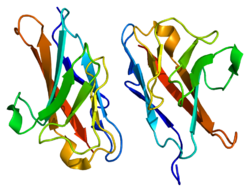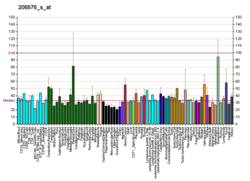CEACAM1 (англ. Carcinoembryonic antigen-related cell adhesion molecule 1 (biliary glycoprotein); CD66a) — гликопротеин семейства раково-эмбриональных антигенов, продукт гена человека CEACAM1[1].
Функции
Ген кодирует белок семейства раково-эмбриональных антигенов суперсемейства иммуноглобулинов. Первоначально белок был обнаружен в желчных протоках печени как гликопротеин желчи. Впоследствии было обнаружено, что это белок межклеточной адгезии, который экспрессируется на лейкоцитах, эпителии и эндотелии. Опосредует межклеточную адгезию как с помощью гомофильных, так и гетерофильных взаимодействий с другими белками этой группы. Играет роль в дифференцировке, регулировке трёхмерного расположения клеток в тканях, ангиогенезе, апоптозе, подавлении опухоли, метастазировании и модуляции как врождённного, так и адаптивного иммунитета. Существует нескл;ко изоформ белка[1].
Взаимодействия
CEACAM1 взаимодействует с фосфатазой PTPN11[3] и аннексином A2.[4]
Примечания
- 1 2 Entrez Gene: CEACAM1 carcinoembryonic antigen-related cell adhesion molecule 1 (biliary glycoprotein).
- ↑ Hoek KS, Schlegel NC, Eichhoff OM, Widmer DS, Praetorius C, Einarsson SO, Valgeirsdottir S, Bergsteinsdottir K, Schepsky A, Dummer R, Steingrimsson E (December 2008). “Novel MITF targets identified using a two-step DNA microarray strategy”. Pigment Cell & Melanoma Research. 21 (6): 665—76. DOI:10.1111/j.1755-148X.2008.00505.x. PMID 19067971.
- ↑ Huber M, Izzi L, Grondin P, Houde C, Kunath T, Veillette A, Beauchemin N (January 1999). “The carboxyl-terminal region of biliary glycoprotein controls its tyrosine phosphorylation and association with protein-tyrosine phosphatases SHP-1 and SHP-2 in epithelial cells”. The Journal of Biological Chemistry. 274 (1): 335—44. DOI:10.1074/jbc.274.1.335. PMID 9867848.
- ↑ Kirshner J, Schumann D, Shively JE (December 2003). “CEACAM1, a cell-cell adhesion molecule, directly associates with annexin II in a three-dimensional model of mammary morphogenesis”. The Journal of Biological Chemistry. 278 (50): 50338—45. DOI:10.1074/jbc.M309115200. PMID 14522961.
Литература
- Gray-Owen SD, Blumberg RS (June 2006). “CEACAM1: contact-dependent control of immunity”. Nature Reviews. Immunology. 6 (6): 433—46. DOI:10.1038/nri1864. PMID 16724098.
- Svenberg T, Hammarström S, Zeromski J (June 1979). “Immunofluorescence studies on the occurrence and localization of the CEA-related biliary glycoprotein I (BGP I) in normal human gastrointestinal tissues”. Clinical and Experimental Immunology. 36 (3): 436—41. PMC 1537745. PMID 385181.
- Thompson J, Zimmermann W, Osthus-Bugat P, Schleussner C, Eades-Perner AM, Barnert S, Von Kleist S, Willcocks T, Craig I, Tynan K (April 1992). “Long-range chromosomal mapping of the carcinoembryonic antigen (CEA) gene family cluster”. Genomics. 12 (4): 761—72. DOI:10.1016/0888-7543(92)90307-E. PMID 1572649.
- Kuroki M, Arakawa F, Matsuo Y, Oikawa S, Nakazato H, Matsuoka Y (April 1991). “Three novel molecular forms of biliary glycoprotein deduced from cDNA clones from a human leukocyte library”. Biochemical and Biophysical Research Communications. 176 (2): 578—85. DOI:10.1016/S0006-291X(05)80223-2. PMID 2025273.
- Hinoda Y, Neumaier M, Hefta SA, Drzeniek Z, Wagener C, Shively L, Hefta LJ, Shively JE, Paxton RJ (September 1988). “Molecular cloning of a cDNA coding biliary glycoprotein I: primary structure of a glycoprotein immunologically crossreactive with carcinoembryonic antigen”. Proceedings of the National Academy of Sciences of the United States of America. 85 (18): 6959—63. DOI:10.1073/pnas.85.18.6959. PMC 282098. PMID 2457922.
- Barnett TR, Kretschmer A, Austen DA, Goebel SJ, Hart JT, Elting JJ, Kamarck ME (February 1989). “Carcinoembryonic antigens: alternative splicing accounts for the multiple mRNAs that code for novel members of the carcinoembryonic antigen family”. The Journal of Cell Biology. 108 (2): 267—76. DOI:10.1083/jcb.108.2.267. PMC 2115422. PMID 2537311.
- Neumaier M, Paululat S, Chan A, Matthaes P, Wagener C (November 1993). “Biliary glycoprotein, a potential human cell adhesion molecule, is down-regulated in colorectal carcinomas”. Proceedings of the National Academy of Sciences of the United States of America. 90 (22): 10744—8. DOI:10.1073/pnas.90.22.10744. PMC 47854. PMID 7504281.
- Formisano P, Najjar SM, Gross CN, Philippe N, Oriente F, Kern-Buell CL, Accili D, Gorden P (October 1995). “Receptor-mediated internalization of insulin. Potential role of pp120/HA4, a substrate of the insulin receptor kinase”. The Journal of Biological Chemistry. 270 (41): 24073—7. DOI:10.1074/jbc.270.26.15844. PMID 7592607.
- Frängsmyr L, Baranov V, Prall F, Yeung MM, Wagener C, Hammarström S (July 1995). “Cell- and region-specific expression of biliary glycoprotein and its messenger RNA in normal human colonic mucosa”. Cancer Research. 55 (14): 2963—7. PMID 7606710.
- Najjar SM, Philippe N, Suzuki Y, Ignacio GA, Formisano P, Accili D, Taylor SI (July 1995). “Insulin-stimulated phosphorylation of recombinant pp120/HA4, an endogenous substrate of the insulin receptor tyrosine kinase”. Biochemistry. 34 (29): 9341—9. DOI:10.1021/bi00029a009. PMID 7626603.
- Nédellec P, Turbide C, Beauchemin N (July 1995). “Characterization and transcriptional activity of the mouse biliary glycoprotein 1 gene, a carcinoembryonic antigen-related gene”. European Journal of Biochemistry / FEBS. 231 (1): 104—14. DOI:10.1111/j.1432-1033.1995.tb20676.x. PMID 7628460.
- Watt SM, Fawcett J, Murdoch SJ, Teixeira AM, Gschmeissner SE, Hajibagheri NM, Simmons DL (July 1994). “CD66 identifies the biliary glycoprotein (BGP) adhesion molecule: cloning, expression, and adhesion functions of the BGPc splice variant”. Blood. 84 (1): 200—10. PMID 8018919.
- Hauck W, Nédellec P, Turbide C, Stanners CP, Barnett TR, Beauchemin N (July 1994). “Transcriptional control of the human biliary glycoprotein gene, a CEA gene family member down-regulated in colorectal carcinomas”. European Journal of Biochemistry / FEBS. 223 (2): 529—41. DOI:10.1111/j.1432-1033.1994.tb19022.x. PMID 8055923.
- Barnett TR, Drake L, Pickle W (February 1993). “Human biliary glycoprotein gene: characterization of a family of novel alternatively spliced RNAs and their expressed proteins”. Molecular and Cellular Biology. 13 (2): 1273—82. DOI:10.1128/mcb.13.2.1273. PMC 359012. PMID 8423792.
- Kuroki M, Yamanaka T, Matsuo Y, Oikawa S, Nakazato H, Matsuoka Y (August 1995). “Immunochemical analysis of carcinoembryonic antigen (CEA)-related antigens differentially localized in intracellular granules of human neutrophils”. Immunological Investigations. 24 (5): 829—43. DOI:10.3109/08820139509060710. PMID 8543346.
- Huber M, Izzi L, Grondin P, Houde C, Kunath T, Veillette A, Beauchemin N (January 1999). “The carboxyl-terminal region of biliary glycoprotein controls its tyrosine phosphorylation and association with protein-tyrosine phosphatases SHP-1 and SHP-2 in epithelial cells”. The Journal of Biological Chemistry. 274 (1): 335—44. DOI:10.1074/jbc.274.1.335. PMID 9867848.
- Feuk-Lagerstedt E, Jordan ET, Leffler H, Dahlgren C, Karlsson A (November 1999). “Identification of CD66a and CD66b as the major galectin-3 receptor candidates in human neutrophils”. Journal of Immunology. 163 (10): 5592—8. PMID 10553088.
- Soni P, Lakkis M, Poy MN, Fernström MA, Najjar SM (June 2000). “The differential effects of pp120 (Ceacam 1) on the mitogenic action of insulin and insulin-like growth factor 1 are regulated by the nonconserved tyrosine 1316 in the insulin receptor”. Molecular and Cellular Biology. 20 (11): 3896—905. DOI:10.1128/MCB.20.11.3896-3905.2000. PMC 85733. PMID 10805733.
- Ergün S, Kilik N, Ziegeler G, Hansen A, Nollau P, Götze J, Wurmbach JH, Horst A, Weil J, Fernando M, Wagener C (February 2000). “CEA-related cell adhesion molecule 1: a potent angiogenic factor and a major effector of vascular endothelial growth factor”. Molecular Cell. 5 (2): 311—20. DOI:10.1016/S1097-2765(00)80426-8. PMID 10882072.
- Wang L, Lin SH, Wu WG, Kemp BL, Walsh GL, Hong WK, Mao L (August 2000). “C-CAM1, a candidate tumor suppressor gene, is abnormally expressed in primary lung cancers”. Clinical Cancer Research. 6 (8): 2988—93. PMID 10955775.
Данная страница на сайте WikiSort.ru содержит текст со страницы сайта "Википедия".
Если Вы хотите её отредактировать, то можете сделать это на странице редактирования в Википедии.
Если сделанные Вами правки не будут кем-нибудь удалены, то через несколько дней они появятся на сайте WikiSort.ru .



